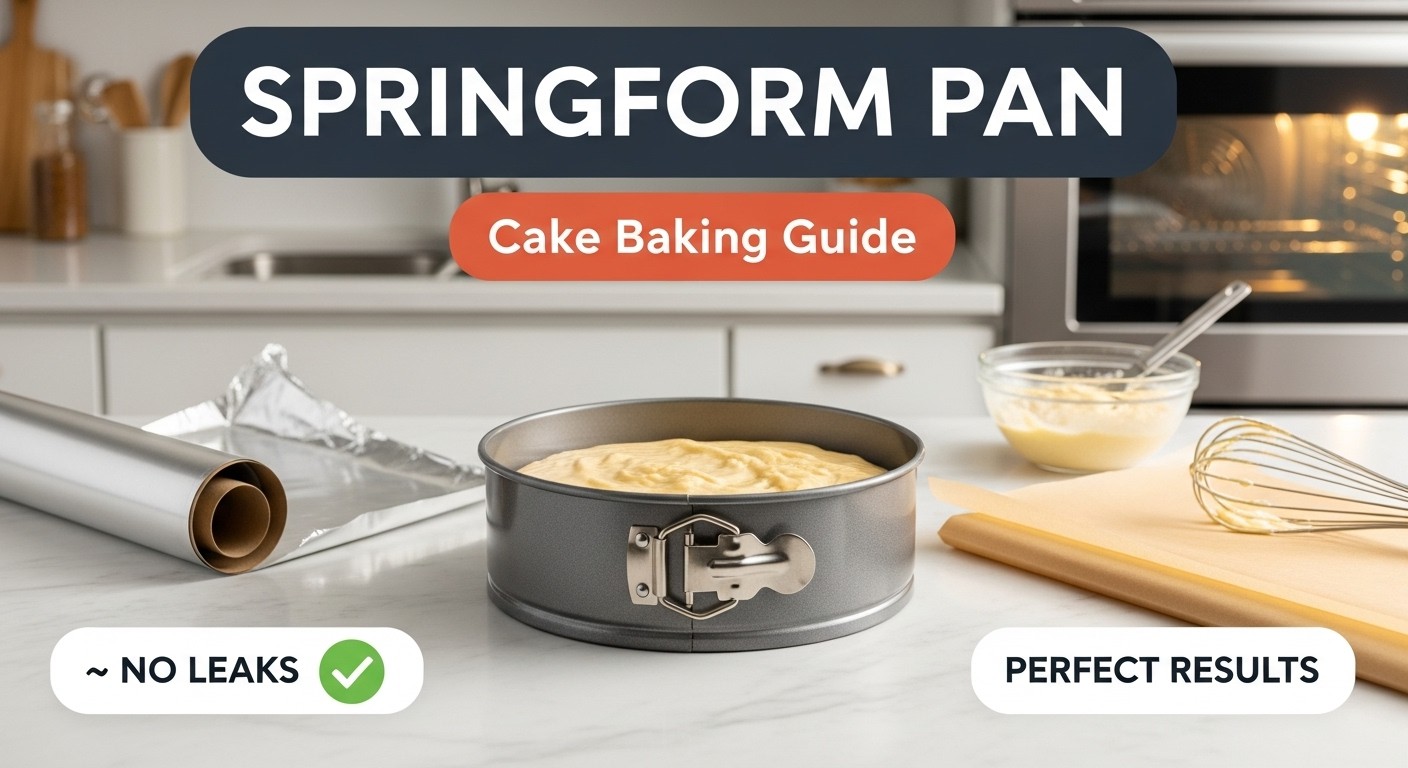
You know that moment when you're standing in front of your oven, watching batter slowly drip from the bottom of your springform pan onto the oven floor? Yeah, I've been there. It's not fun. But here's the thing: after years of baking everything from birthday cakes to elaborate layer cakes in springform pans, I've learned that leaking doesn't have to be your destiny.
Springform pans are amazing when you know how to use them properly. They make releasing delicate cakes a breeze, create stunning presentations, and honestly, once you get the hang of them, you'll wonder why you ever struggled with flipping cakes out of regular pans. Let me walk you through everything I wish someone had told me before my first springform pan disaster.
What Makes Springform Pans Different from Regular Cake Pans
The first time I used a springform pan, I didn't really understand what made it special beyond the cool release mechanism. I just thought it was a fancy cake pan with a removable bottom. But there's actually more to it than that.
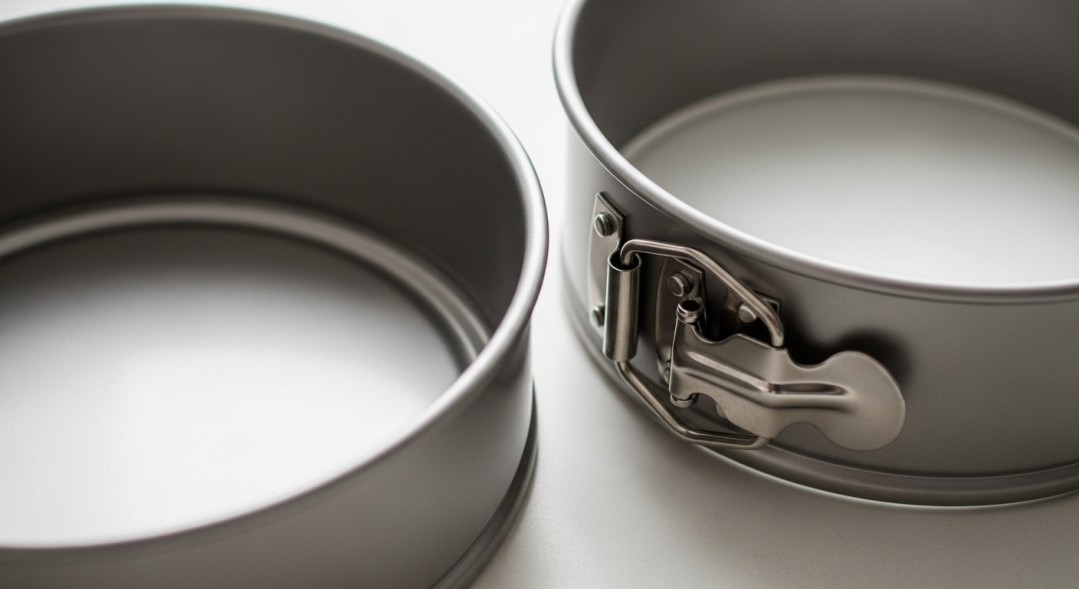
A springform pan has two separate pieces: a flat base and a ring with a latch that clamps around it. When you unlatch it, the ring springs open (hence the name), and you can lift it right off your finished cake. No flipping, no crossing your fingers, no hoping for the best.
Originally, these pans were designed for cheesecakes and delicate European tortes—desserts that would fall apart if you tried to turn them upside down. The problem is, that two-piece design creates a potential gap where the base meets the ring. And that gap? That's where your cake batter wants to escape.
I learned this the hard way with a chocolate cake that seemed perfectly fine going into the oven, then left a brown puddle on my oven bottom twenty minutes later. The gap isn't huge, but it's definitely there, especially on older pans or cheaper models where the fit isn't quite as tight.
Can You Actually Bake Regular Cakes in a Springform Pan?
Short answer: absolutely yes. I do it all the time now.
But let me be real with you—not every cake batter is created equal when it comes to springform pans. I've had the best success with thicker batters like pound cakes, carrot cakes, and chocolate cakes made with oil instead of butter. These batters have enough body that they don't immediately try to find every possible escape route.
Thinner batters, like some vanilla cakes or genoise, need a bit more babysitting. They're not impossible, but you'll want to take some precautions (which I'll get to in a minute).
The real beauty of using a springform pan for regular cakes is the presentation. When I make layer cakes, I bake each layer in a springform pan. The sides come out perfectly straight, there's no dome to trim off, and I don't risk breaking the cake while trying to wrestle it out of a traditional pan. Plus, when you're making something like a mousse cake or a cake with delicate decorations, being able to remove the sides without touching the cake itself is a game-changer.
The Leaking Question: What You Need to Know
Let's talk about the elephant in the room—or rather, the batter on the oven floor.
Will your batter leak? Maybe. I hate to be wishy-washy, but it really depends on a few factors. The consistency of your batter matters most. When I made a super-thin funfetti cake batter last month, I watched it start seeping within five minutes of going into the oven. But the dense lemon pound cake I made the week before? Not a single drop escaped.
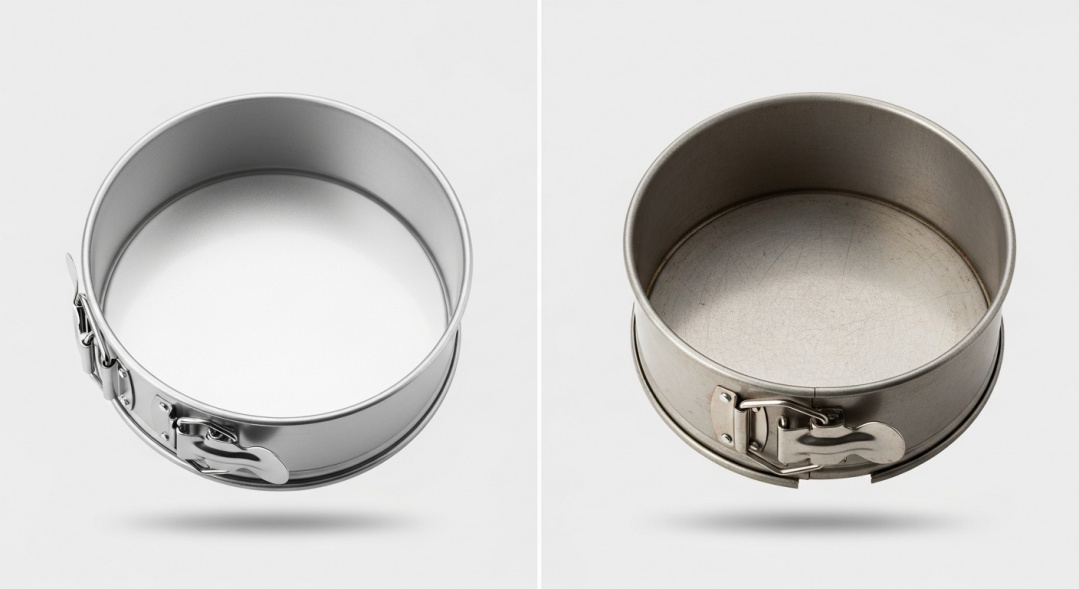
The quality and age of your pan also plays a huge role. My newer springform pan has a much tighter seal than the one I bought at a discount store five years ago. That older pan? It leaks almost every time unless I take preventive measures. The latch has gotten a bit loose, and the base doesn't fit quite as snugly as it used to.
Here's what I've observed: minor seepage is actually pretty common and not the end of the world. A few drops of batter might escape, but your cake will be fine. It's the major leaks—where you lose a significant amount of batter—that you want to prevent. Those can leave you with a lopsided cake or, worse, a smoke-filled kitchen.
The good news? Major leaks are completely preventable if you take a few simple steps.
Foolproof Methods to Prevent Leaking
After dealing with enough messes, I've developed a system. These are the methods I actually use in my kitchen, and I'll tell you which one I reach for most often.
Method 1: Aluminum Foil Wrapping
This is my go-to method for thinner batters or when I'm using my older pan. I tear off a large piece of heavy-duty aluminum foil and place the springform pan in the center. Then I bring the foil up around the sides of the pan, pressing it snugly against the base and lower part of the ring. I usually do two layers if I'm really worried.
Does it look pretty? No. Does it work? Absolutely. I haven't had a single leak since I started doing this consistently.
The key is making sure the foil extends at least halfway up the sides of the pan. Too short, and batter can still find its way out. I learned this when I only wrapped the bottom and still ended up with leaks—the batter just traveled along the base and dripped off the edge.
Method 2: Parchment Paper Base
This one is brilliant for two reasons: it prevents leaks AND makes removing your cake even easier.
I trace the bottom of my springform pan onto parchment paper, cut it out, and place it inside the pan before latching the ring. The parchment creates an extra barrier between the batter and that gap where the base meets the ring. Plus, when the cake is done, it slides right off the base with the parchment underneath.
I use this method for almost every cake now, even when I'm not worried about leaking. It's just good practice.
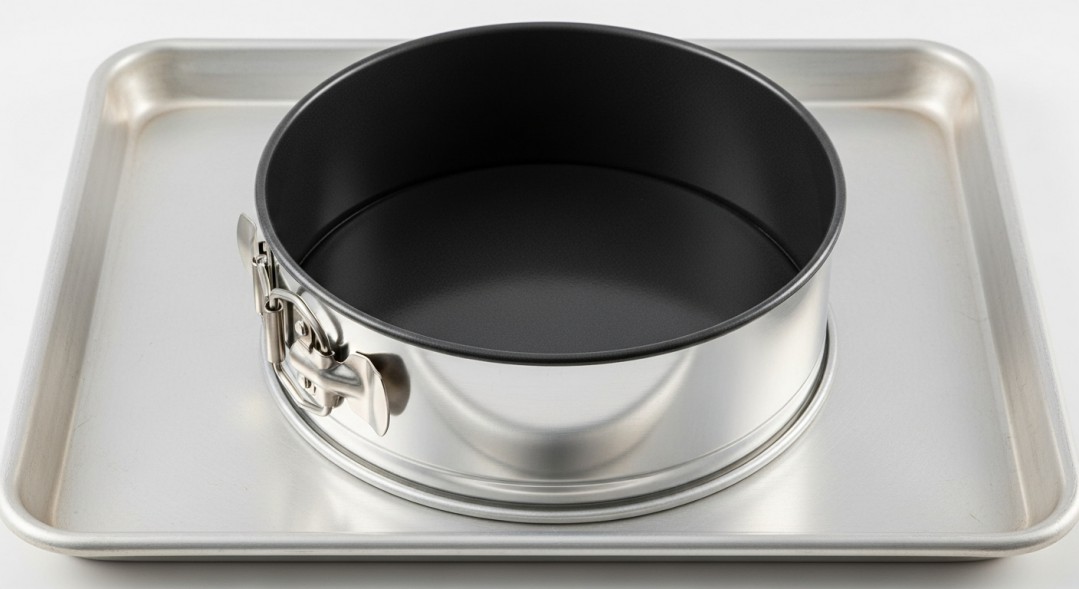
Method 3: The Baking Sheet Solution
This is the "I'm not taking any chances" method. I simply place my springform pan on a rimmed baking sheet before putting it in the oven.
Does this prevent leaking? No. But it catches any drips, which means no smoke, no burning smell, and no scraping baked batter off your oven floor later. I consider it insurance. Even when I use the foil method, I still put a baking sheet underneath because I'm paranoid like that.
Method 4: Pan Quality Check
Before I add any batter, I always—and I mean always—check that my pan is assembled correctly. It sounds obvious, but I once had a leak because I hadn't latched the ring tightly enough. The latch should click firmly into place, and you shouldn't be able to see any obvious gaps.
Here's a test I do with new pans or if I'm using a pan I haven't touched in a while: I put the empty pan together, pour in a cup of water, and let it sit for a minute. If water leaks out, batter definitely will. This saved me just last month when I realized my sister's springform pan had a bent base that wouldn't seal properly.
How Much Batter Should You Use?
This is where I've made some of my biggest mistakes. Overfilling a springform pan is basically asking for trouble—both from leaking and from overflow once the cake rises.
Springform pans come in different sizes, and knowing the capacity of yours is crucial. The most common size is 9 inches, which holds about 10 to 11 cups of batter when filled to the top. But—and this is important—you should never fill it to the top.
My rule is simple: fill the pan no more than two-thirds full. For my 9-inch pan, that means about 6 to 7 cups of batter maximum. This gives the cake room to rise without spilling over the top or putting pressure on that base seal.
When I'm converting a recipe from a regular cake pan, I do a quick calculation. A standard 9-inch round pan holds about 8 cups filled to the brim, so two-thirds full would be around 5 to 6 cups. If my recipe makes more batter than that, I either make cupcakes with the extra or bake a second smaller cake.
For smaller springform pans, like the 7-inch I use for special occasion cakes, I stick to about 4 to 5 cups of batter. My 10-inch pan can handle up to 8 cups comfortably. Going over these amounts has never ended well for me—I've had overflowing batter and increased leaking every single time.
Recipe Adaptations and Best Practices
Not all cake recipes translate perfectly to springform pans, and I've learned which ones are worth the effort and which ones aren't.
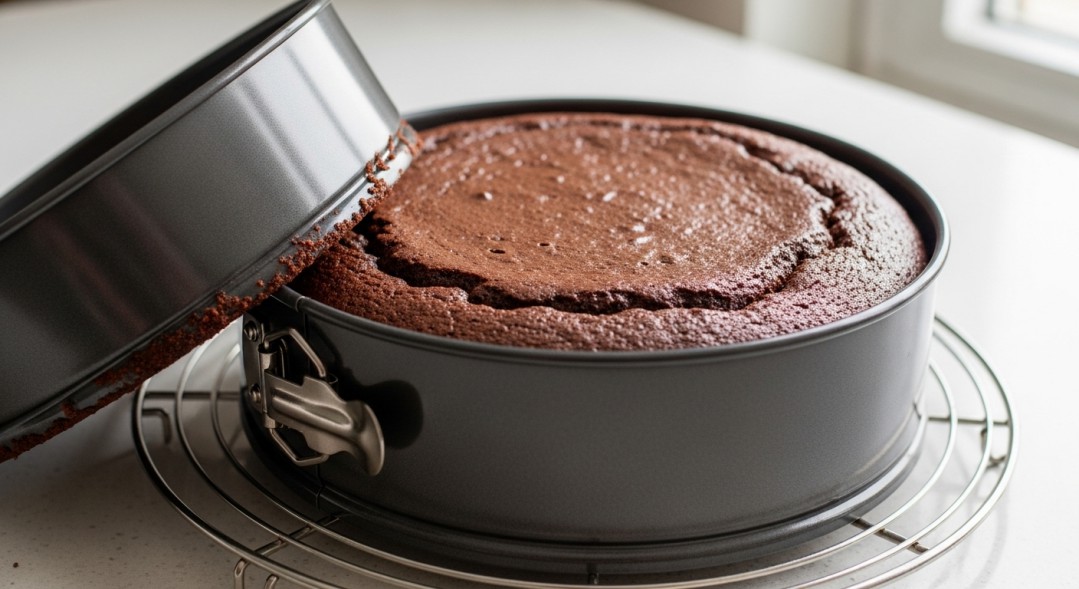
Pound cakes are absolutely perfect for springform pans. The thick, dense batter stays put, and the straight sides of the pan create that beautiful, professional look. I make a sour cream pound cake in my springform pan all the time, and it's never leaked once.
Oil-based cakes, like many chocolate cakes and carrot cakes, also work wonderfully. The batter is typically thick enough that leaking isn't a major concern, and the cakes turn out incredibly moist. I made a chocolate olive oil cake for a dinner party last fall in my springform pan, and everyone asked how I got the sides so smooth and perfect.
But some recipes need adjustments. Angel food cakes and other recipes that depend on the batter climbing up the sides of the pan? Skip the springform. These need a tube pan with feet to hang upside down while cooling. I tried once and ended up with a flat, sad cake.
Super liquidy batters, like some tres leches cakes or very thin sponge cakes, require extra vigilance. I always use both the foil method and a baking sheet underneath for these. Even then, I watch them carefully during the first 15 minutes of baking—that's when most leaks happen, before the batter has a chance to set.
Temperature matters too. I've noticed that baking at slightly lower temperatures (like 325°F instead of 350°F) can help prevent leaks because the batter sets more gradually. This doesn't work for every recipe, but it's been helpful for cakes that are on the thinner side.
Baking times in a springform pan can vary from what the recipe states. The metal of the springform pan conducts heat differently than a regular pan, and the removable bottom can affect how the cake bakes. I usually start checking for doneness about 5 minutes earlier than the recipe suggests, then check every few minutes after that. A toothpick inserted in the center should come out with just a few moist crumbs.
Troubleshooting Common Issues
Even with the best preparation, things can go wrong. Here's what I do when they do.
If I notice leaking during baking, I try not to panic. Opening the oven door constantly makes things worse. Instead, I place a baking sheet on the rack below to catch drips if I haven't already. The cake will usually still turn out fine, just maybe a bit shorter than intended.
Stuck cakes are frustrating after you've been so careful. This usually happens when I forget to grease the sides of the pan properly. Now I always butter and flour the ring, even though people say the removable sides make it unnecessary. I also run a thin knife around the edge before unlatching the ring—just a gentle pass to make sure nothing's clinging.
Sometimes cakes bake unevenly, with the edges getting done before the center. I've found this happens more in springform pans than regular pans because of the gap at the bottom. Using a lower temperature and a longer baking time helps. I also invested in a cake strip—one of those strips you soak and wrap around the outside of the pan—and it's made a noticeable difference in how evenly my cakes bake.
Cakes that sink in the middle are usually underbaked or opened too early. I'm guilty of peeking too much, especially when I'm worried about leaking. But every time I open that oven door, the temperature drops and can cause the cake to fall. Now I force myself to wait at least until the recipe's minimum baking time before even looking.
Pro Tips from My Kitchen
After years of trial and error, here are the little things that make a big difference.
I grease my springform pans even more thoroughly than regular pans. I use soft butter and a pastry brush to get into the corner where the base meets the ring. Then I dust it with flour, tapping out the excess. For chocolate cakes, I use cocoa powder instead of flour so there's no white residue on the finished cake.
The cooling process is crucial. I let my cakes cool in the pan for about 15 to 20 minutes before releasing the ring. Too soon and the cake might collapse; too long and it might stick. I also place the pan on a cooling rack so air can circulate underneath—this prevents the bottom from getting soggy.
Taking care of your springform pan matters. I hand-wash mine instead of putting it in the dishwasher because the high heat can warp the base or weaken the latch mechanism. I've seen friends' pans get ruined this way. I also store mine with the ring open so the spring doesn't lose its tension over time.
There comes a point when you need to retire a springform pan. If the latch is broken, the base is warped, or you can see visible gaps even when it's properly assembled, it's time to invest in a new one. A good springform pan should last years, but they're not indestructible. I finally replaced my first one after five years when I realized I was spending more time preventing leaks than actually enjoying the baking.
Ready to Bake with Confidence
Here's what I want you to take away from all this: springform pans are not scary. Yes, they can leak, but so can regular pans overflow if you fill them too full. The difference is that with a springform pan, you have easy solutions that actually work.
Start with the parchment paper method—it's simple, effective, and you probably already have parchment in your kitchen. If you're working with a particularly thin batter or an older pan, add the foil wrap for extra insurance. And always, always use a baking sheet underneath until you know how your specific pan behaves with different recipes.
The versatility of these pans is worth the small learning curve. Being able to create perfectly shaped cakes with minimal effort, release delicate desserts without damage, and present stunning layer cakes that look like they came from a professional bakery—that's why I keep reaching for my springform pan despite having a drawer full of other options.
I'd love to hear about your experiences with springform pans. Have you had any spectacular successes or dramatic failures? Drop a comment and let me know what's worked (or hasn't worked) in your kitchen. We're all learning together, and sometimes the best tips come from fellow bakers who've been in the trenches.
Now go ahead—grab that springform pan and bake something amazing. You've got this.
Leave a Reply